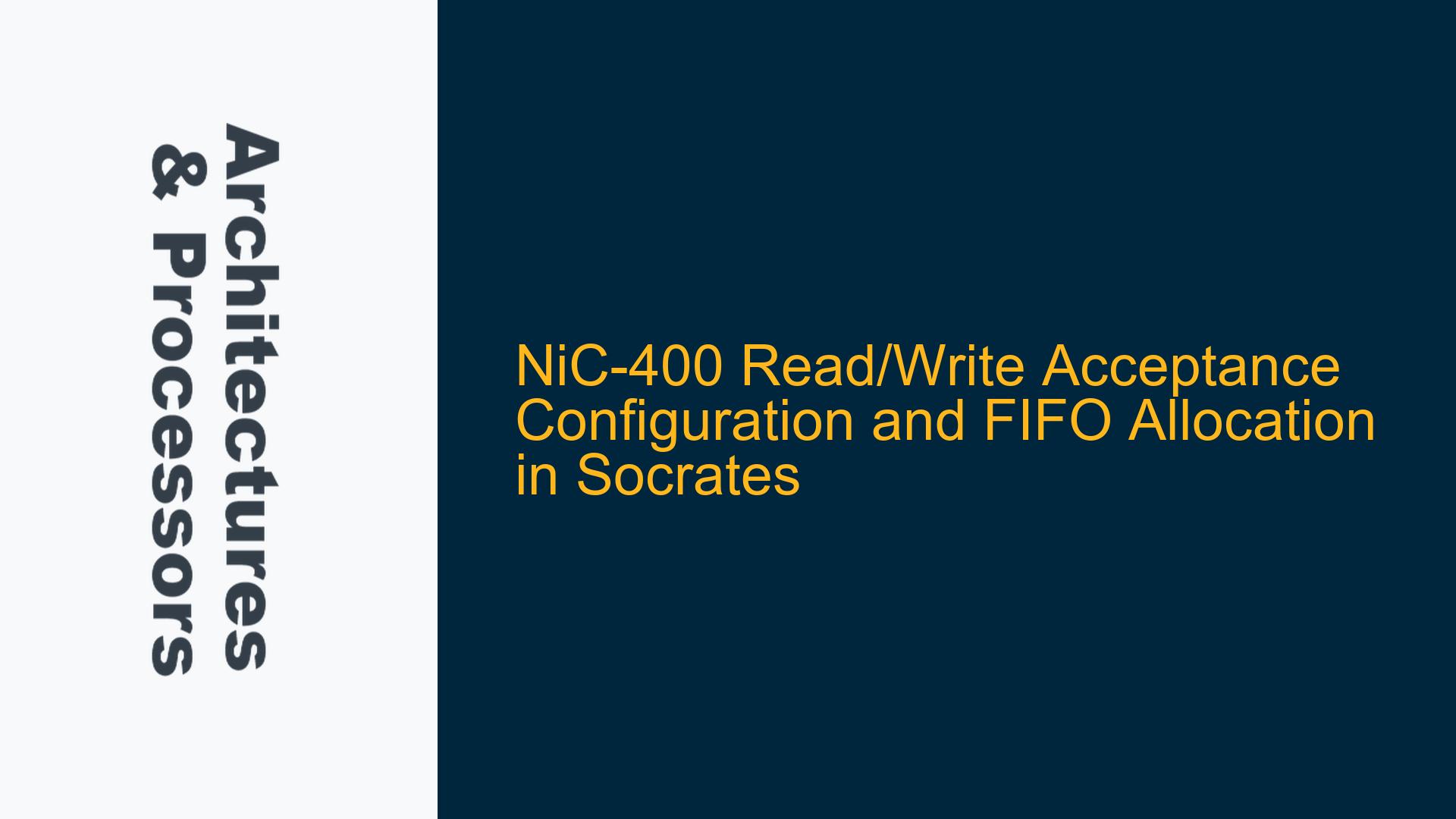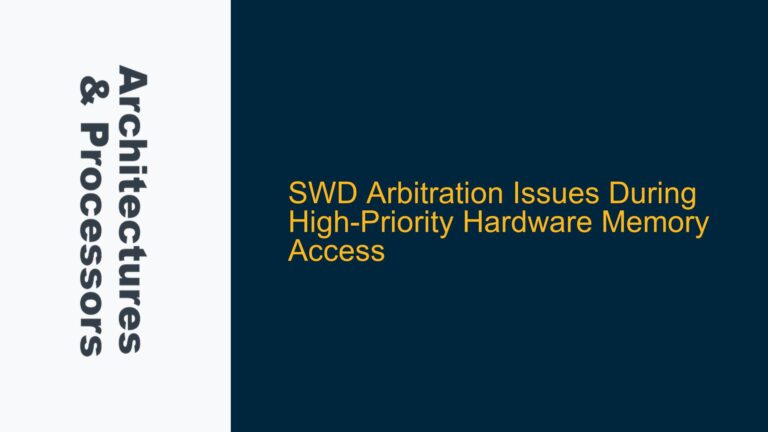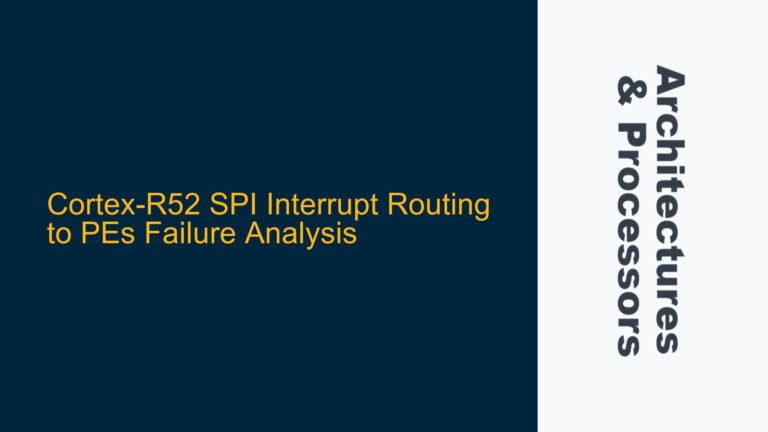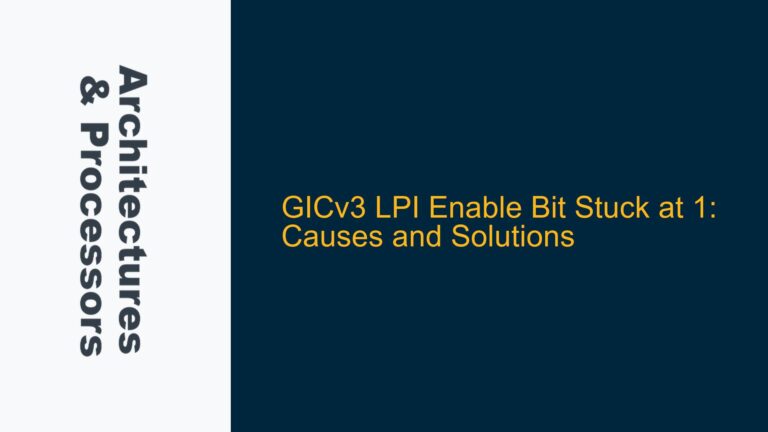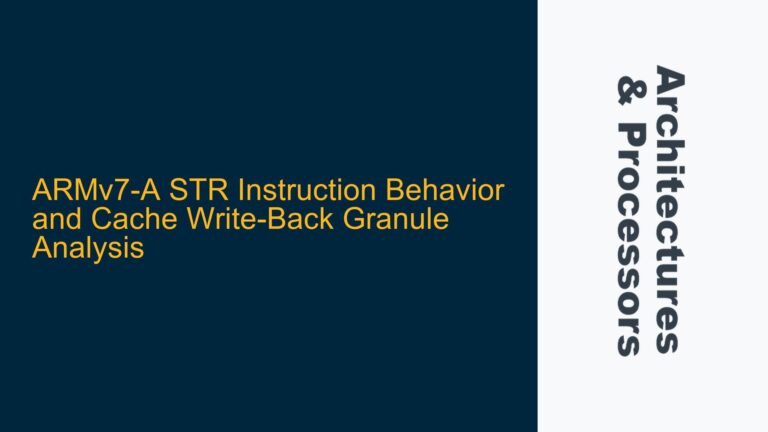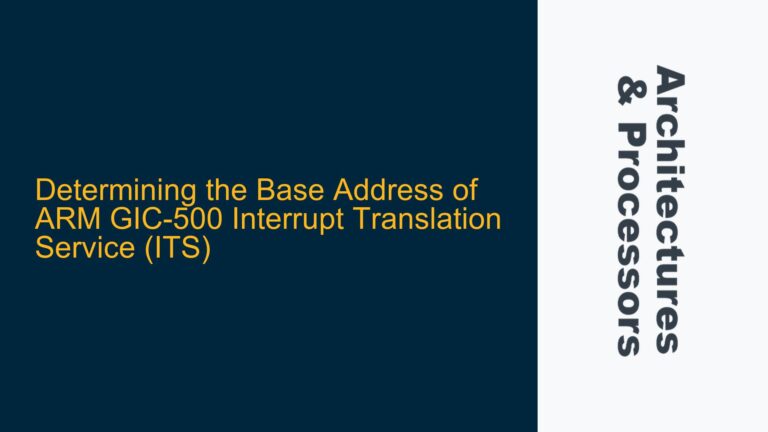NiC-400 Read/Write Acceptance Configuration and FIFO Allocation
The NiC-400 interconnect is a highly configurable and scalable interconnect IP from ARM, designed to facilitate efficient communication between multiple initiators and targets in an ARM-based SoC. One of the key features of the NiC-400 is its ability to manage read and write transactions with configurable acceptance and issue policies. These policies are crucial for optimizing the performance of the interconnect, especially in systems with multiple outstanding transactions and complex data flows.
When configuring the NiC-400 in Socrates (ARM’s system configuration tool), one of the primary considerations is how the interconnect handles the allocation of FIFOs (First-In-First-Out buffers) in the datapath. FIFOs are essential for managing the flow of data between initiators and targets, especially when there are variations in the speed at which data can be processed by different components in the system. The allocation of FIFOs is directly influenced by the read and write acceptance/issue configuration, which determines how the interconnect manages the flow of transactions.
The read and write acceptance/issue configuration in the NiC-400 is typically set up to control how many transactions can be accepted and issued by the interconnect at any given time. This configuration is critical for managing the interconnect’s resources, such as FIFOs, and ensuring that the system can handle multiple outstanding transactions without causing bottlenecks or deadlocks. The configuration also affects the interconnect’s ability to handle backpressure from targets, which can occur when a target is unable to accept additional transactions due to resource constraints.
In the context of FIFO allocation, the NiC-400 interconnect typically allocates FIFOs in the datapath based on the configured acceptance and issue policies. For example, if the interconnect is configured to accept a certain number of read and write transactions, it will allocate FIFOs in the respective channels to buffer the data associated with these transactions. The size and depth of these FIFOs are usually determined by the configuration settings in Socrates, which allow designers to specify the maximum number of transactions that can be buffered at any given time.
The allocation of FIFOs in the datapath is also influenced by the interconnect’s ability to handle multiple outstanding transactions. The NiC-400 supports multiple outstanding transactions through the use of the CDAS (Command Data Address Split) protocol, which allows the interconnect to split the command, data, and address phases of a transaction. This capability is particularly important in systems where initiators and targets operate at different speeds, as it allows the interconnect to manage the flow of transactions more efficiently.
However, the ability to handle multiple outstanding transactions is also dependent on the read and write acceptance/issue configuration. If the configuration is set to a minimum value (e.g., 1), the interconnect may not be able to support multiple outstanding transactions, as it would be limited to accepting and issuing only one transaction at a time. This could lead to performance degradation, especially in systems with high transaction throughput requirements.
In summary, the read and write acceptance/issue configuration in the NiC-400 interconnect plays a critical role in determining how FIFOs are allocated in the datapath and how the interconnect handles multiple outstanding transactions. The configuration settings in Socrates allow designers to optimize the interconnect’s performance by balancing the allocation of resources, such as FIFOs, with the system’s transaction throughput requirements.
Impact of Minimum Read/Write Acceptance Configuration on Multiple Outstanding Transactions
The NiC-400 interconnect’s ability to handle multiple outstanding transactions is heavily influenced by the read and write acceptance/issue configuration. When the configuration is set to a minimum value, such as 1, the interconnect’s behavior changes significantly, potentially impacting the system’s overall performance and efficiency.
In a typical scenario, the NiC-400 interconnect is designed to handle multiple outstanding transactions by allowing initiators to issue multiple read and write requests without waiting for the previous transactions to complete. This capability is essential for achieving high throughput in systems where initiators and targets operate at different speeds or where there are long latency paths between components.
However, when the read and write acceptance/issue configuration is set to a minimum value, the interconnect’s ability to handle multiple outstanding transactions is severely restricted. In this case, the interconnect can only accept and issue one transaction at a time, which means that initiators must wait for the current transaction to complete before issuing the next one. This can lead to significant performance degradation, especially in systems with high transaction throughput requirements.
The impact of a minimum read/write acceptance configuration on multiple outstanding transactions can be further understood by examining the role of the CDAS (Command Data Address Split) protocol. The CDAS protocol allows the NiC-400 interconnect to split the command, data, and address phases of a transaction, enabling the interconnect to manage the flow of transactions more efficiently. However, when the acceptance/issue configuration is set to a minimum value, the benefits of the CDAS protocol are diminished, as the interconnect is unable to take full advantage of its ability to handle multiple outstanding transactions.
In addition to the impact on transaction throughput, a minimum read/write acceptance configuration can also affect the interconnect’s ability to handle backpressure from targets. Backpressure occurs when a target is unable to accept additional transactions due to resource constraints, such as a full FIFO or a busy state. In a system with a minimum acceptance configuration, the interconnect may be unable to buffer additional transactions, leading to increased latency and potential deadlocks.
To mitigate the impact of a minimum read/write acceptance configuration on multiple outstanding transactions, designers can consider several strategies. One approach is to increase the acceptance/issue configuration to a value that allows the interconnect to handle multiple outstanding transactions without causing resource contention. This can be achieved by carefully analyzing the system’s transaction throughput requirements and adjusting the configuration settings in Socrates accordingly.
Another approach is to optimize the allocation of FIFOs in the datapath to ensure that the interconnect has sufficient buffering capacity to handle multiple outstanding transactions. This may involve increasing the depth of the FIFOs or adjusting the interconnect’s arbitration policies to prioritize certain types of transactions.
In summary, the impact of a minimum read/write acceptance configuration on multiple outstanding transactions in the NiC-400 interconnect can be significant, leading to performance degradation and potential deadlocks. Designers must carefully consider the system’s transaction throughput requirements and adjust the configuration settings in Socrates to ensure that the interconnect can handle multiple outstanding transactions efficiently.
Optimizing NiC-400 Configuration for FIFO Allocation and Multiple Outstanding Transactions
Optimizing the NiC-400 interconnect’s configuration for FIFO allocation and multiple outstanding transactions is a critical step in ensuring the overall performance and efficiency of an ARM-based SoC. The configuration settings in Socrates play a key role in determining how the interconnect manages resources, such as FIFOs, and how it handles the flow of transactions between initiators and targets.
One of the first steps in optimizing the NiC-400 configuration is to carefully analyze the system’s transaction throughput requirements. This involves understanding the expected number of read and write transactions that the system will need to handle, as well as the latency requirements for these transactions. Based on this analysis, designers can determine the appropriate acceptance/issue configuration for the interconnect, ensuring that it can handle multiple outstanding transactions without causing resource contention.
In addition to the acceptance/issue configuration, designers must also consider the allocation of FIFOs in the datapath. FIFOs are essential for managing the flow of data between initiators and targets, especially in systems with varying processing speeds. The size and depth of the FIFOs should be carefully chosen to ensure that the interconnect has sufficient buffering capacity to handle multiple outstanding transactions. This may involve increasing the depth of the FIFOs or adjusting the interconnect’s arbitration policies to prioritize certain types of transactions.
Another important consideration when optimizing the NiC-400 configuration is the use of the CDAS (Command Data Address Split) protocol. The CDAS protocol allows the interconnect to split the command, data, and address phases of a transaction, enabling it to manage the flow of transactions more efficiently. Designers should ensure that the interconnect is configured to take full advantage of the CDAS protocol, especially in systems with high transaction throughput requirements.
To further optimize the NiC-400 configuration, designers can also consider the use of advanced features such as QoS (Quality of Service) and priority-based arbitration. QoS allows the interconnect to prioritize certain types of transactions based on their importance, ensuring that critical transactions are processed with minimal latency. Priority-based arbitration, on the other hand, allows the interconnect to allocate resources based on the priority of the transactions, ensuring that high-priority transactions are handled first.
In addition to these configuration settings, designers should also consider the impact of backpressure from targets. Backpressure occurs when a target is unable to accept additional transactions due to resource constraints, such as a full FIFO or a busy state. To mitigate the impact of backpressure, designers can adjust the interconnect’s configuration to ensure that it has sufficient buffering capacity to handle multiple outstanding transactions without causing resource contention.
Finally, designers should thoroughly test the NiC-400 configuration in a simulation environment to ensure that it meets the system’s performance and efficiency requirements. This involves running a series of test cases that simulate various transaction scenarios, including multiple outstanding transactions, backpressure from targets, and varying processing speeds. Based on the results of these tests, designers can make further adjustments to the configuration settings to optimize the interconnect’s performance.
In summary, optimizing the NiC-400 configuration for FIFO allocation and multiple outstanding transactions is a critical step in ensuring the overall performance and efficiency of an ARM-based SoC. Designers must carefully analyze the system’s transaction throughput requirements, adjust the acceptance/issue configuration, optimize FIFO allocation, and take full advantage of advanced features such as the CDAS protocol, QoS, and priority-based arbitration. By following these steps, designers can ensure that the NiC-400 interconnect is configured to handle multiple outstanding transactions efficiently, without causing resource contention or performance degradation.
